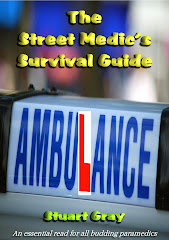Five emergency calls; one GP referral and four by ambulance.
A 26 year-old man lay writhing in agony on a bench after dislocating his shoulder playing squash. He had done this before but was initially panicky, despite his experience with the injury. He was hyperventilating and demanding a paper bag when I arrived but he got entonox and a sling instead and this brought him back down to earth; the gas has a very beneficial effect in these situations, so he became much more manageable after a few minutes and was practically cheery by the time he was taken to the ambulance.
A crew was on scene and dealing with my next call, for a 50 year-old epileptic man at a homeless shelter. Whether his fit was brought on by his illness or alcohol remains to be seen.
A call for a 1 year-old ‘shaken up’ in a taxi had me wondering if the baby was injured after a crash or had been given a fright and was just emotional and I arrived to find that the taxi had struck a bus at a busy junction. Luckily, the child (and her mother) seemed unhurt. Her son had sustained a bump to the head after hitting it on part of the structure of his buggy when the cab suddenly braked. An ambulance was requested so that he could be checked out and his mother could be reassured.
The baby had been properly restrained in the push-chair but if he had been in his mother's arms at the time of the collision, the call would have had a completely different urgency about it.
Deep south next, for a 71 year-old man with Parkinson’s disease who’d become very ill and had DIB. His carer of ten years, a man who’d been awarded the MBE for his service to the patient, was concerned and told me that he’d never had to call an ambulance before in all that time. The patient was in bed and, although he could speak, communication was often difficult but enough was gleaned from him to determine that he didn’t feel right at all. His chest wasn’t expanding properly on the upper right and so it’s possible he may have a lung injury, although the cause seemed a mystery.
I was told that he moved around his flat by crawling on the floor, so I figured he may have fallen or hit something during one of those expeditions. He was taken quickly to hospital by ambulance with oxygen to supplement his breathing.
The Physician Response Unit (PRU) is a primary care emergency doctor who uses a fast response car to get to patients in the City and parts of the east of London and I worked with him on the last call of the shift. A 42 year-old woman had collapsed at work with palpitations and dizziness (which go hand in hand). She had no previous history of this but she did suffer from PCOS, although I couldn’t see any relationship and neither could the doc. She was given Metformin for her condition, which seemed strange as it is primarily used for type II diabetes but she told us that it was a new drug treatment for PCOS. I wondered if her symptoms were related to side effects.
She was given a thorough examination, including an ECG and advised to see her own GP when she could. Her condition had stabilised and the doctor didn’t feel it necessary for her to go to hospital. The PRU’s role is essentially to reduce the number of ambulances required by carrying out exams and treatment on the spot. Unfortunately, it only runs out of one hospital and serves only a small part of the community...not my area though, which is a shame because we’d probably save a small fortune if we had one.
Be safe.
Subscribe to:
Post Comments (Atom)















2 comments:
You are right about Metformin being a treatment for diabetes. But it is also used in Polycystic Ovarian Syndrome (PCOS) as there is insulin resistance as part of it. Endocrinologically this can be complex.
JD.
Jobbing doctor
Thanks...I wonder if you could explain it for me by email when you have time. I'd like to learn about this.
Post a Comment